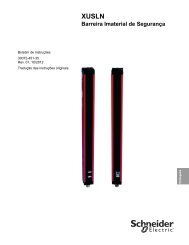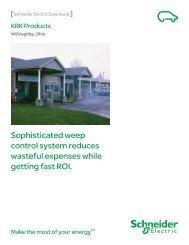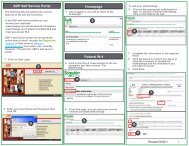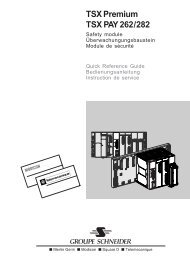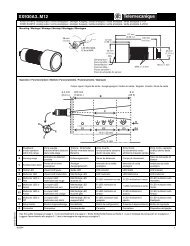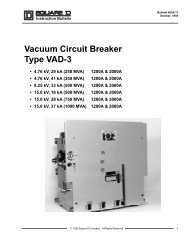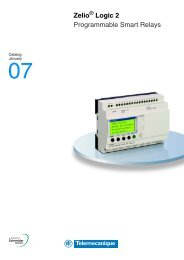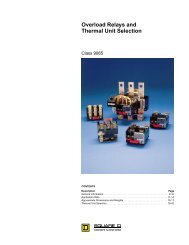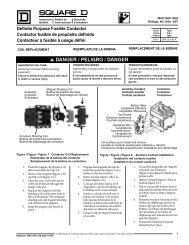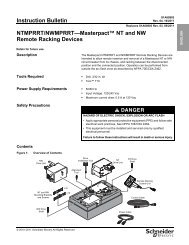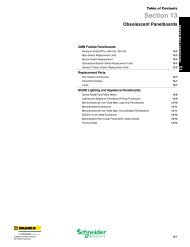Altivar 31 - Square D
Altivar 31 - Square D
Altivar 31 - Square D
Create successful ePaper yourself
Turn your PDF publications into a flip-book with our unique Google optimized e-Paper software.
Example of wiring:<br />
LI1: forward<br />
LIx: reverse<br />
LIy: +speed (USP)<br />
563543.eps<br />
f (Hz)<br />
Forward 1<br />
or<br />
Reverse 0<br />
1<br />
Jog 0<br />
Speed reference:<br />
adjustable from 0 to 10 Hz<br />
factory setting = 10 Hz<br />
Example of jog operation<br />
ATV<strong>31</strong> Control Terminals<br />
LI1 LIx LIy + 24<br />
tm<br />
a c<br />
b d<br />
tm: fixed time of 0.5 s,<br />
minimum time between<br />
two pulses<br />
8800CT0401_Double Action Button<br />
t<br />
t<br />
t<br />
Double action buttons<br />
<strong>Altivar</strong> ® <strong>31</strong> Adjustable Speed AC Drives<br />
Functions<br />
Only one logic input, assigned to +speed, is required for double action<br />
buttons. Double action buttons typically have two detents. Press the button to<br />
the first detent to maintain speed; press it to the second detent to increase<br />
speed. Each action closes a contact. Refer to the following table.<br />
Button<br />
This type of +/- Speed is incompatible with three-wire control.<br />
The maximum speed is set by HSP.<br />
Save reference<br />
This function, associated with +/- Speed control, enables the drive to save<br />
and read the last speed reference. If the run signal or mains supply is lost,<br />
the drive applies the saved reference at the next run signal.<br />
Jog operation<br />
Released<br />
(-speed)<br />
Press to 1 st detent<br />
(speed maintained)<br />
Forward — a a and b<br />
Reverse — c c and d<br />
Motor frequency<br />
LSP<br />
0<br />
LSP<br />
Forward<br />
2nd press<br />
1st press<br />
0<br />
Reverse<br />
2nd press<br />
1st press<br />
0<br />
b b<br />
a a a a a a a<br />
Press to 2 nd detent<br />
(+speed)<br />
The jog function permits pulse operation with minimum ramp times (0.1 s),<br />
limited speed reference, and minimum time between two pulses. It is enabled<br />
using a logic input, with pulses given by the rotation direction command.<br />
This function is suited to machines with product insertion in manual mode<br />
(for example, gradual movement of the mechanism during maintenance<br />
operations).<br />
4/2005 © 2004–2005 Schneider Electric All Rights Reserved<br />
d<br />
c c<br />
8800CT0401_Plus Speed_Minus Speed.eps<br />
39



